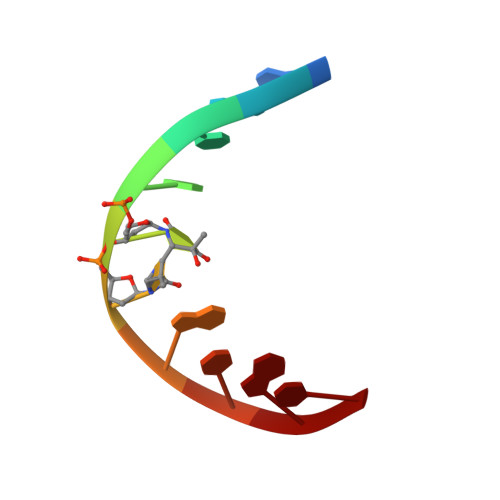The Dewar Photoproduct of Thymidylyl(3'-->5')-Thymidine (Dewar Product) Exhibits Mutagenic Behavior in Accordance with the "A Rule".
Lee, J.-H., Bae, S.-H., Choi, B.-S.(2000) Proc Natl Acad Sci U S A 97: 4591
- PubMed: 10758155
- DOI: https://doi.org/10.1073/pnas.080057097
- Primary Citation of Related Structures:
1QKG - PubMed Abstract:
In contrast to the highly mutagenic pyrimidine(6-4)pyrimidone photoproduct, its Dewar valence isomer (Dewar product) has low mutagenic potential and produces a broad range of mutations [LeClerc, J. E., Borden, A. & Lawrence, C. W. (1991) Proc. Natl. Acad. Sci. USA 88, 9685-9689]. To determine the origin of the mutagenic property of the Dewar product, we used experimental NMR restraints and molecular dynamics to determine the solution structure of a Dewar-lesion DNA decamer duplex. This DNA decamer duplex (DW/GA duplex) contains a mismatched base pair between the 3' T residue of the Dewar lesion (T6) and an opposed G residue (G15). The 3' T (T6) of the Dewar lesion formed stable hydrogen bonds with the opposing G15 residue. However, the helical bending and unwinding angles of the DW/GA duplex were much larger than those of a second duplex that contains the Dewar lesion and opposing A15 and A16 residues (DW/AA duplex). The DW/GA duplex showed poorer stacking interactions at the two bases of the Dewar product and at the adjacent A7 small middle dotT14 base pair than did the DW/AA duplex. These structural features imply that no thermal stability or conformational benefit is obtained by incorporating a G instead of an A opposite the 3' T of the Dewar lesion. These properties may thus facilitate the preferential incorporation of an A in accordance with the A rule during translesion replication and lead to the low frequency of 3' T-->C mutations observed at this site.
Organizational Affiliation:
Department of Chemistry and School of Molecular Science (BK21), Korea Advanced Institute of Science and Technology, 373-1, Kusong-dong, Yusong-gu, Taejon 305-701, Korea.















